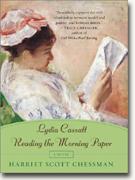Lydia Cassatt Reading the Morning Paper
Harriet Scott Chessman
book reviews:
· general fiction
· chick lit/romance
· sci-fi/fantasy
· graphic novels
· nonfiction
· audio books
· author interviews
· children's books @
curledupkids.com
· DVD reviews @
curledupdvd.com
newsletter
win books
buy online
links
home
for authors
& publishers
for reviewers

 |
Lydia Cassatt Reading the Morning Paper Harriet Scott Chessman Plume Paperback 172 pages November 2002 |
|
Lydia Cassatt Reading The Morning Paper takes place in Paris and in the French countryside in the late 19th century. Based on the lives of the American Impressionist painter, Mary Cassatt and her older sister, Lydia, this is an imaginative and tender novel.
Unfortunately, Lydia was extremely ill and frail, suffering from Bright's Disease, a degenerative kidney condition. From time to time, she regained sufficient strength to pose for her sister, feeling not to do so when asked would be to "betray" Mary. Lydia was both honored and humbled by the experience. Five plates of these paintings are included in the book: Woman Reading; The Cup of Tea; Lydia Crocheting in the Garden; Woman and Child Driving [a horse]; and Lydia at a Tapestry Frame. Woman Reading is also on the cover, immediately drawing many readers in by its beauty and calming effect. These personal portraits seem less sentimental than many of Cassatt's famous mother and child paintings. The novel meanders, through the completion of the five paintings, various meetings, picnics and Parisian art exhibitions. Lydia's health declines, sending her to her bed for days and then weeks. In the novel, we learn that Lydia was also a creative woman -- not only as a cooperative model, but also as a craftswoman who made pillowcases and doll dresses for various children. Although she had wished for marriage and a child (Mary had no such desire), as she neared death, Lydia found a new fulfillment in being the model for her sister's work: "I think about how I've created something with May [Mary], something that was not on earth before.. I think I could fly home instead of walking."Several novels of the last few years have plumbed artists' lives, but this small book may be unique in that it covers only a few short years and primarily one aspect of the narrator's and her sister's lives. In checking the historical validity of the events, one finds that the two sisters did live together in Paris; Lydia died of Bright's disease in 1882. Mary painted her older sister 11 times; those portraits now hang in the U.S. and in France. The painter lived until 1926. Chessman, who has also written about another American in Paris, Gertrude Stein (The Public is Invited to Dance), tells her readers about this book's conception: " I have thought, imagined, and dreamt my way into her [Lydia's] world." Chessman has quite successfully taken her readers into this 19th century artistic world. However, because of the book's slow pace and delicacy, her female readers will likely be most easily transported. © 2002 by Deborah Straw for Curled Up With a Good Book |
|
|
|
 Click here to learn more about this month's sponsor! |
|
| fiction · sf/f · comic books · nonfiction · audio newsletter · free book contest · buy books online review index · links · · authors & publishers reviewers |
|
| site by ELBO Computing Resources, Inc. | |
 The sisters were extremely intimate in several ways. Lydia often served
as Mary's model. They lived together into adulthood with their parents.
Neither ever married, although both flirted with Mary's friend and
mentor, Edgar Degas, during the time period of the book, 1878 to 1881
(When Lydia first met Degas, he reminded her of "an intelligent but
fierce dog." The "fierce dog" part changed, as he became kind to her).
The sisters were extremely intimate in several ways. Lydia often served
as Mary's model. They lived together into adulthood with their parents.
Neither ever married, although both flirted with Mary's friend and
mentor, Edgar Degas, during the time period of the book, 1878 to 1881
(When Lydia first met Degas, he reminded her of "an intelligent but
fierce dog." The "fierce dog" part changed, as he became kind to her).